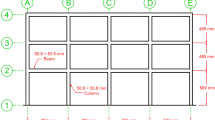Abstract
Motivated by the seismic damage observed to reinforced concrete (RC) frame structures during the Wenchuan earthquake, the effect of infill walls on the seismic performance of a RC frame is studied in this paper. Infill walls, especially those made of masonry, offer some amount of stiffness and strength. Therefore, the effect of infill walls should be considered during the design of RC frames. In this study, an analysis of the recorded ground motion in the Wenchuan earthquake is performed. Then, a numerical model is developed to simulate the infill walls. Finally, nonlinear dynamic analysis is carried out on a RC frame with and without infill walls, respectively, by using CANNY software. Through a comparative analysis, the following conclusions can be drawn. The failure mode of the frame with infill walls is in accordance with the seismic damage failure pattern, which is strong beam and weak column mode. This indicates that the infill walls change the failure pattern of the frame, and it is necessary to consider them in the seismic design of the RC frame. The numerical model presented in this paper can effectively simulate the effect of infill walls on the RC frame.
Similar content being viewed by others

References
Cao Wanlin and Wang Guangyuan(1997), “Calculation of Earthquake Action on Frame with Special-shaped Columns and Light-weight Filled Walls at Elastic Stage,” Journal of Earthquake Engineering and Engineering Vibration, 17(3): 20–31. (in Chinese)
Chaker AA and Cherifati Arslan (1999), “Influence of Masonry Infill Panels on the Vibration and Stiffness Characteristics of R/C Frame Buildings,” Earthquake Engineering and Structural Dynamics, 28(9): 1061–1065.
Code for Seismic Design Buildings (2001), Beijing: China Architecture & Building Press. (in Chinese)
Guo Zixiong, Wu Yibin and Huang Qunxian (2008), “Research and Development in seismic Behavior of Inf illed Frame Structures,” Journal of Earthquake Engineering and Engineering Vibration, 28(6): 172–177. (in Chinese)
Hoshikuma J, Kawashima K, Nagaya K and Taylor A W(1997), “Stress-strain Model for Confined Reinforced Concrete in Bridge Piers,” Journal of Structural Engineering, ASCE, 123(5): 624–633.
Hu Yuxian (2010), Earthquake Engineering, Beijing: Earthquake Publish Company. (in Chinese)
Kwon Oh-Sung and Kim Eungsoo (2009), “Case Study: Analytical Investigation on the Failure of a Two-story RC Building Damaged During the 2007 Pisco-Chincha Earthquake,” Engineering Structures, 22:1–12.
Li Kangning(2004), CANNY 2004 Technical Manual.
Li Yingmin, Han Jun, Tian Qixiang, Chen Weixian and Zhao Shengwei (2009), “Study on Influence of Infilled walls on Seismic Performance of RC Frame Structures,” Earthquake Engineering and Engineering Vibration, 29(3): 51–58. (in Chinese)
Mónica Puglisi, Maylett Uzcategui and Julio Flórez-López (2009a), “Modeling of Masonry of Infilled Frames, Part I: The Plastic Concentrator,” Engineering Structures, 31: 113–118.
Mónica Puglisi, Maylett Uzcategui and Julio Flórez-López (2009b), “Modeling of Masonry of Infilled Frames, Part II: Cracking and Damage,” Engineering Structures, 31: 119–124.
Paulay T and Priestley MJN (1991), Seismic Design of Reinforced Concrete and Masonry Buildings, New York: John Wiley & Sons, Inc.
Qian Jiaru and Zhao Zuozhou (2008), Investigation of Building Damages in Wenchuan Earthquake and Reconstruction Report After the Earthquake, Beijing: China Architecture & Building Press. (in Chinese)
Shi Qingxuan, Tong Yuesheng and Qian Guofang (1996), “Earthquake Response Analysis for Reinforced Concrete Frames With Masonry Filler Walls,” Journal of Xi’an University of Architecture & Technology, 28(4): 423–427. (in Chinese)
Yang Wei, Hou Shuang and Ou Jinping (2009), “Analysis of Influence of Structural Global Seismic Capacity Induced by Infills Subjected to Wenchuan Earthquake,” Journal of Dalian University of Technology, 49(5): 770–775. (in Chinese)
Zhu Bolong (1990), Design principle of masonry structure, Shanghai: Tongji University Press. (in Chinese)
Author information
Authors and Affiliations
Corresponding author
Rights and permissions
About this article
Cite this article
Zhang, C., Zhou, Y., Zhou, D. et al. Study on the effect of the infill walls on the seismic performance of a reinforced concrete frame. Earthq. Eng. Eng. Vib. 10, 507–517 (2011). https://doi.org/10.1007/s11803-011-0085-x
Received:
Accepted:
Published:
Issue Date:
DOI: https://doi.org/10.1007/s11803-011-0085-x



